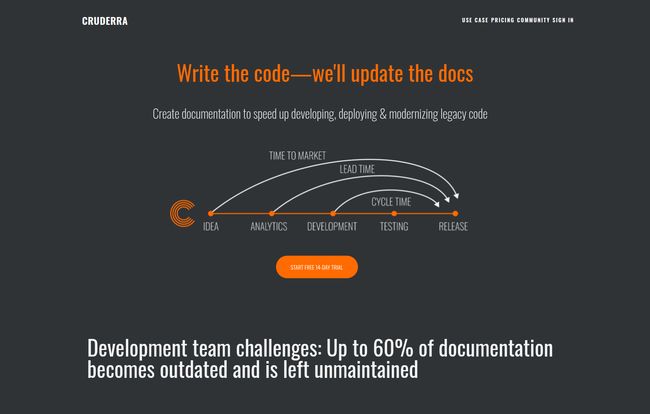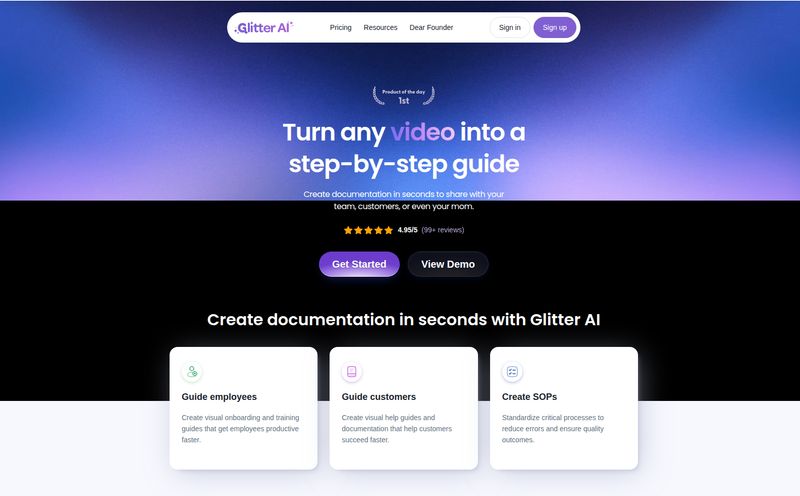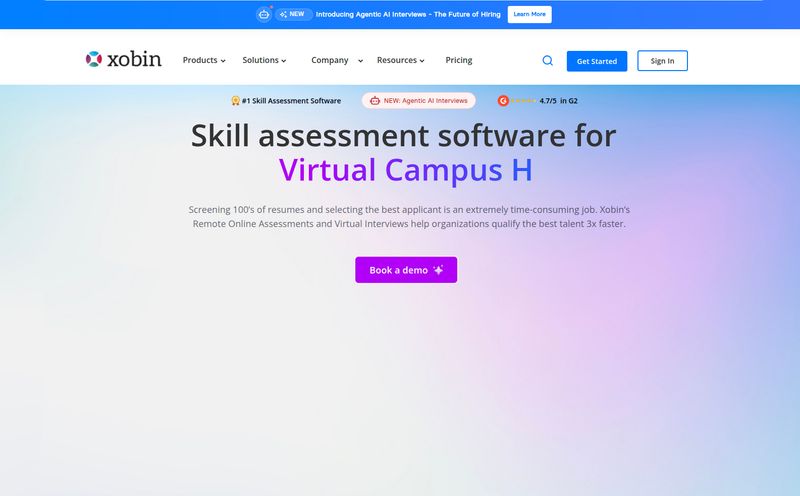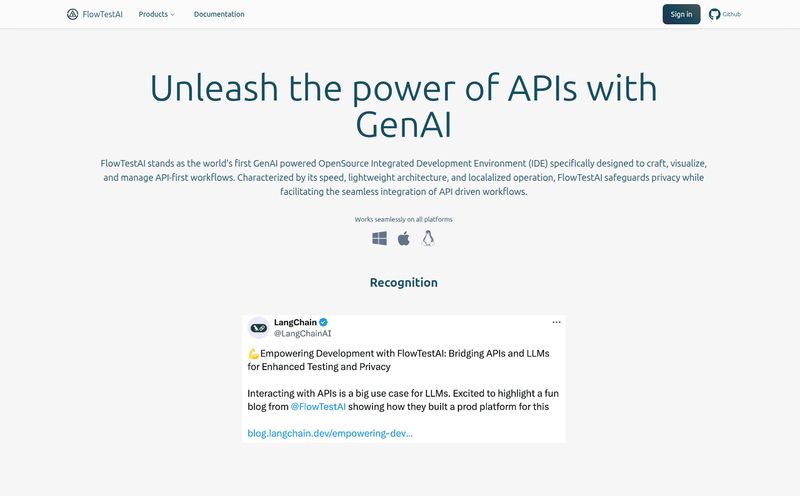How many times have you onboarded a new developer, handed them the “documentation,” and watched the light slowly fade from their eyes? We’ve all been there. That sacred wiki, once a source of truth, is now a collection of half-truths, outdated diagrams, and comments from engineers who left the company two years ago. The stats I've seen floating around suggest up to 60% of development team documentation is basically useless because it's outdated. And honestly? That feels low.
This isn't just an annoyance; it's a productivity killer. It’s the sand in the gears of your development cycle, the ghost in the machine that turns a simple feature update into a week-long archeological dig. For years, we've just accepted this as the cost of doing business. We call it “technical debt,” shrug, and pour another coffee. But what if we didn’t have to?
I’ve been keeping my eye on the “DocOps” space for a while now, and a platform called Cruderra recently caught my attention. It makes a bold promise: “Write the code—we’ll update the docs.” As a guy who’s seen countless projects get bogged down by documentation drift, that’s a pretty compelling hook. So, I decided to take a closer look.
The Vicious Cycle of Documentation Debt
Before we get into the tool itself, let’s just sit with the problem for a second. It’s not just about new hires. It’s about the constant misalignment between what the business thinks the system does and what it actually does. It’s about production errors cropping up because a critical API change was never documented. It’s about feature development slowing to a crawl because no one is 100% sure what touching a certain microservice will break.
Your best developers, the ones you pay to solve complex problems, end up spending a shocking amount of their time just trying to build a mental map of the current architecture. It’s a massive, invisible tax on every single line of code they write. It's a frustrating, soul-crushing part of the job that we've been trying to solve with process and discipline, but let's face it, that rarely works for long.
What is Cruderra, Exactly? (And Why It's Not Just Another “AI” Tool)
Cruderra positions itself as an AI-powered DocOps platform. In plain English, it’s a system designed to automatically create and maintain your technical documentation and architecture diagrams by watching your code.
This is where it gets interesting. The core idea is Architecture as Code. Instead of drawing diagrams in some separate tool that's immediately out of date, you define and describe your architecture in a way that lives with your code. Cruderra then takes over, acting like a tireless scribe that never forgets to update the records.

Visit Cruderra
Now, I know what you’re thinking. “AI.” It’s the buzzword of the decade. Most of the time, it just means a company is using an OpenAI API wrapper. Here's the kicker I found on their site, and it’s a big one: Cruderra says, “We don't use OpenAI - we build our own neural network from scratch.” This is a massive claim. It suggests a deeper, more specialized approach to understanding the nuances of codebases and software architecture, rather than a generalist model. As a tech enthusiast, that gets my attention. It’s a bold move, and it tells me they’re serious about solving this specific problem.
A Closer Look at Cruderra’s Features
So what does it actually do? I’ve been digging through its offerings, and a few things stand out.
True "Architecture as Code"
This isn’t just about generating docs from code comments. Cruderra seems to be about creating a living, breathing model of your system. By analyzing the code, it can generate UML diagrams, trace dependencies between microservices, and provide a real-time view of your architecture. For teams dealing with a complex web of services, this is like swapping a hand-drawn treasure map for a live GPS.
Reverse Engineering and Real-Time Tracing
This is probably the most compelling feature for anyone with a mountain of legacy code. Cruderra can scan your existing codebase and reverse-engineer the architecture. It untangles the spaghetti for you. That means you can get a clear picture of what you have, not just what you're building. This automated technical documentation could be a game changer for modernization projects.
Interactive Docs and Collaboration
The output isn't a static PDF. The documentation it generates is interactive. This is crucial for collaboration between developers, QAs, and even product managers. It supports popular standards like OpenAPI 3.1 and AsyncAPI, which is a must-have for modern API-driven development. It’s about creating a single source of truth that everyone on the team can actually use and understand.
My Honest Take: The Good and The Not-So-Good
No tool is perfect, right? From my perspective, here’s how Cruderra stacks up.
The advantages are obvious. You accelerate development by freeing up your senior engineers from being human wikis. You improve team collaboration and reduce the friction between dev and business teams. Onboarding a new devleoper could go from taking a month to a week. That’s a huge return on investment.
However, there are potential hurdles. The documentation I found suggests there might be a learning curve. If your team isn’t familiar with concepts like PlantUML or a code-first approach to documentation, there will be an adjustment period. You're also placing a lot of trust in the AI to get things right. While it's a massive help, it's not a replacement for human oversight. You still need smart engineers to validate the output and make a judgement call. But that's a much better use of their time than drawing boxes and arrows.
Let's Talk Money: Cruderra's Pricing
Now for the part every manager scrolls down to first… the price tag. Cruderra seems to have a straightforward pricing model, which I always appreciate.
- TEAM Plan: This is priced at $28 per user per month. It’s designed for teams of up to 5 users and includes the AI features. They also mention a 20% discount, which is a nice incentive.
- ENTERPRISE Plan: This is for larger organizations (5+ users) or those who need an on-premise solution. The pricing is custom, so you'll have to contact them for a quote. This makes sense for enterprise-level security and support needs.
Is it worth it? Let’s do some back-of-the-napkin math. If a developer costs you $100/hour, and this tool saves them even just 5 hours a month of documentation-related headaches... it's already paid for itself several times over. When you factor in faster feature releases and fewer production errors, the value proposition becomes pretty clear.
So, Who Is This Really For?
In my opinion, Cruderra is a fantastic fit for fast-growing software teams, especially those working with microservices or complex distributed systems. If you're feeling the pain of documentation debt—if your TTM (Time to Market) is slowing down and onboarding is a nightmare—this is a tool you should seriously evaluate. Companies looking to modernize a legacy system could also find the reverse-engineering capabilities incredibly valuable.
It might be overkill for a solo developer or a very small team working on a simple monolith. But for anyone operating at scale, the problem Cruderra solves is not just an inconvenience, it's a major business liability.
Final Thoughts
Look, the old way of doing documentation is broken. We all know it. We've tried to fix it with process, with checklists, with nagging, but human nature always wins. We'd rather build cool stuff than write about the cool stuff we just built.
Tools like Cruderra represent a fundamental shift. They treat documentation not as an afterthought but as an integrated, automated part of the development lifecycle. It’s an ambitious goal, and I’m genuinely excited to see platforms like this taking it on. By letting developers focus on what they do best—coding—Cruderra might just be the solution that finally helps us pay off our technical documentation debt for good.
Frequently Asked Questions
- What is Cruderra in a nutshell?
- Cruderra is a DocOps platform that uses AI to automatically generate and maintain software architecture diagrams and technical documentation directly from your code. Its goal is to eliminate outdated docs and speed up development.
- How does Cruderra's AI work? Is it just OpenAI?
- No, and this is a key point. Cruderra states that they have built their own proprietary neural network from scratch, specifically designed for understanding codebases and software architecture, rather than using a general-purpose model like OpenAI's.
- Is Cruderra suitable for small teams?
- Yes, the TEAM plan is specifically designed for teams of up to 5 users. It provides access to the core AI features at a per-user price, making it accessible for smaller, growing teams.
- What standards and integrations does Cruderra support?
- Cruderra supports key industry standards for API documentation, including OpenAPI 3.1 and AsyncAPI. The platform is built around the concept of 'Architecture as Code' and may require some familiarity with tools like Python or PlantUML for advanced use.
- Can I try Cruderra before I buy it?
- Yes, the website mentions a 14-day free trial, allowing you to test out the platform with your own team and codebase to see if it's a good fit.
- What does "Architecture as Code" mean?
- It means defining and describing your software's structure, components, and interactions using a descriptive, code-like syntax that can be version-controlled and live alongside your application code, rather than using separate graphical tools that quickly become outdated.



